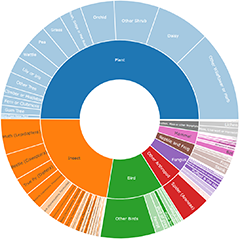Anthelid moths (Anthelidae)
Announcements
There are currently no announcements.
Discussion
JulieMorgan
wrote:
21 min ago
Hi Ian,
I have learned a lot from both you and John and your work on NatureMapr has created a wonderful resource for moth enthusiasts.
To begin, I should say that I am no expert on Anthela. My comments are as a result of my own observations and precious time spent at ANIC learning from people who know a lot more than I do. That said, I also acknowledge that much has happened in the world of moths since that time.
My colleagues in MABA have indicated that Lepidoptera records on ALA are not verified before being posted and so I am cautious when using their records for identification. I look for who has verified the records on iNat as the “wisdom of the crowd” is not always based on knowledge of the species. Looking at the Anthela deficiens records on ALA, the moths posted by Nick Lambert, Desmond Wells and Rebecca Stroud show a different shape to my eye – a boxier shape compared to Anthela acuta.
https://bie.ala.org.au/species/https://biodiversity.org.au/afd/taxa/34cfec67-be9e-400c-8604-59244aa250b4#gallery
John Lenagan’s comments in Rebecca Stoud’s identification indicate that there double spot below the dissecting line on the lower wing and the single spot above the line on the upper wing in A. deficiens. These features are present in these 3 specimens. Based on this, I think that John’s moth (and also Lisa H’s from Moruya) are from the Anthela acuta group but I happy to be corrected as there is much to learn in the world of moths. Julie
I have learned a lot from both you and John and your work on NatureMapr has created a wonderful resource for moth enthusiasts.
To begin, I should say that I am no expert on Anthela. My comments are as a result of my own observations and precious time spent at ANIC learning from people who know a lot more than I do. That said, I also acknowledge that much has happened in the world of moths since that time.
My colleagues in MABA have indicated that Lepidoptera records on ALA are not verified before being posted and so I am cautious when using their records for identification. I look for who has verified the records on iNat as the “wisdom of the crowd” is not always based on knowledge of the species. Looking at the Anthela deficiens records on ALA, the moths posted by Nick Lambert, Desmond Wells and Rebecca Stroud show a different shape to my eye – a boxier shape compared to Anthela acuta.
https://bie.ala.org.au/species/https://biodiversity.org.au/afd/taxa/34cfec67-be9e-400c-8604-59244aa250b4#gallery
John Lenagan’s comments in Rebecca Stoud’s identification indicate that there double spot below the dissecting line on the lower wing and the single spot above the line on the upper wing in A. deficiens. These features are present in these 3 specimens. Based on this, I think that John’s moth (and also Lisa H’s from Moruya) are from the Anthela acuta group but I happy to be corrected as there is much to learn in the world of moths. Julie
Anthela deficiens
ibaird
wrote:
Yesterday
OK, thanks Julie. You are likely to be more familiar with the species than I am. Can you indicate how it's shape differs from A. acuta?
Anthela deficiens
JulieMorgan
wrote:
Yesterday
I have had similar moths in the past (as early as 2010) identified as belonging to the Anthela acuta group by Ted Edwards. I know that a lot of work has been done on Anthela since that identification. I don't think that the shape of the moth is consistent with A. deficiens.
Anthela deficiens
LisaH
wrote:
1 Oct 2025
Hi @ibaird - I've messaged you . . . I have a feeling my messages aren't getting through (not just to you)?
Anthela deficiens
Top contributors
- jb2602 46
- WendyEM 41
- AlisonMilton 29
- Hejor1 27
- kasiaaus 23
- PJH123 20
- HelenCross 16
- LisaH 15
- Harrisi 15
- FeralGhostbat 13
Top moderators
- ibaird 279
- donhe 218
- GlennCocking 37
- WendyEM 25
- DianneClarke 24
- MichaelMulvaney 22
- JulieMorgan 14
- KimPullen 13
- MichaelBedingfield 3
- RogerF 3





















